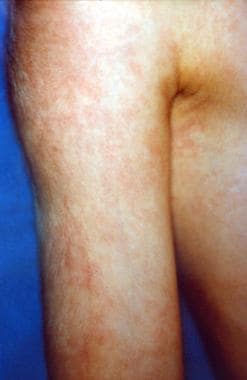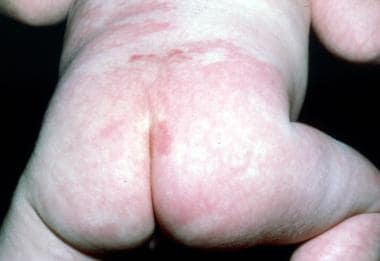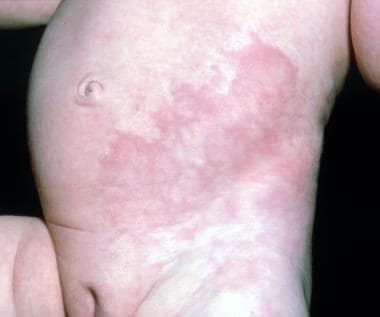Practice Essentials
Cutis marmorata telangiectatica congenita (CMTC) is an uncommon, sporadic, congenital cutaneous vascular anomaly evident as persistent cutis marmorata, telangiectasia, and phlebectasia. [1, 2, 3] CMTC is most commonly localized in distribution, evident over the lower limbs. Ulceration of the involved skin and cutaneous atrophy is described in a number of cases. In addition, CMTC is often reported in association with a variety of other congenital anomalies, including but not limited to undergrowth or overgrowth of an involved extremity.
Body asymmetry is the most common anomaly associated. The body asymmetry is manifest as hypertrophy or hypotrophy of the affected limb; other possibly coincidental malformations include congenital glaucoma, syndactyly, renal hypoplasia, and Kartagener syndrome. [4] However, macrocephaly-cutis marmorata telangiectatica congenita is a recently recognized syndrome. [5] Children with CMTC are at risk of neurologic abnormalities and life-threatening complications. Note the image below.
Signs and symptoms
Also see Physical Examination.
Cutis marmorata telangiectatica congenita (CMTC) is generally present at birth or shortly thereafter. The reticulated mottling frequently becomes more prominent in a cold environment (eg, physiologic cutis marmorata), but it tends not to disappear with rewarming. In one survey, 24.5% had generalized cutis marmorata telangiectatica congenita, 66.8% had localized, and 8.7% had a nonspecified pattern. [6] Note the images below.
Hemangiomas and lymphangiomas have been seen in association with CMTC. Diffuse dermal angiomatosis may also arise in CMTC. [7] The former is a variant of reactive angioendotheliomatosis, often evident clinically as painful, violaceous, nonhealing erosions or ulcers. It is characterized histologically by diffuse endothelial cell hyperplasia within the reticular dermis rather than the intravascular proliferation typical of reactive angiomatosis.
Diagnostics
Physical examination helps in diagnosing cutis marmorata telangiectatica congenita (CMTC). Imaging studies are indicated only for the evaluation of other suspected congenital anomalies. Such studies are specifically performed according to the clinician's suspicion.
This cutaneous vascular disorder may occasional have ocular involvement. Bilateral peripheral retinal vascular abnormalities and retinal nonperfusion on fluorescein angiography without retinal detachment were documented in one patient. [8] Congenital glaucoma, suprachoroidal hemorrhage, and bilateral total retinal detachments resulting in secondary neovascular glaucoma have been described rarely. [9]
Histologic findings
A skin biopsy is not necessary in CMTC because the histologic findings are nonspecific and nondiagnostic. Microscopic findings include dilated capillaries in the deeper dermis, swollen endothelial cells, and sometimes dilated veins or venous lakes.
Management
No treatment is needed for cutis marmorata telangiectatica congenita (CMTC) unless associated anomalies (eg, glaucoma, hypospadias, syndactyly, multicystic renal disease, cardiac malformation, limb asymmetry) require treatment.
The association between retinal detachment and cutis marmorata is salient, as laser photocoagulation may effectively treat the associated retinal detachment. [10]
CMTC has been successfully treated with intense pulsed-light and pulse-dyed laser therapy. [11]
Consultations
Consultation with an orthopedist and/or neurosurgeon may be necessary for evaluation of associated anomalies (eg, limb or cranial defects). Limb-length discrepancy and asymmetry, common in this disorder, may prompt orthopedic referral. [12]
Consultation with an ophthalmologist may be necessary because glaucoma has been reported in association with cutis marmorata telangiectatica congenita. However, all of the patients with glaucoma had periocular skin changes around the affected eye. Therefore, ophthalmologic evaluation is probably only indicated in this setting.
Pathophysiology
The pathogenesis of cutis marmorata telangiectatica congenita (CMTC) remains unclear. Its cause may be multifactorial. Most cases occur sporadically, although rare cases occur in families. Cases of CMTC are reported in association with fetal ascites [13] and an elevated maternal beta-human chorionic gonadotropin (beta-hCG) level, although a direct relationship has not been established. ARL6IP6 was documented to be mutated in a patient with syndromic CMTC in a consanguineous Arabian family. [14]
Some authors suggest that the Happle lethal gene hypothesis (ie, the lethal dominant gene survives by means of mosaicism) best explains the patchy distribution of the lesions and sporadic occurrence of the disease. Other authors suggest that a possible teratogen is the cause, and yet others consider CMTC to be an autosomal dominant genetic disorder with incomplete penetrance. CMTC can be caused by mosaic GNA11 mutations and thus may belong to the GNA11-Related Capillary Nevus (GNARCAN) spectrum. [15]
CMTC is described to occur in association with other discrete syndromes such as Sturge-Weber syndrome and Klippel-Trenaunay syndrome. Some have suggested that Sturge-Weber syndrome, Klippel-Trenaunay syndrome, and CMTC may be included in a group of vascular diseases that are associated with other developmental defects of the mesodermal system during embryonic life. [16] A novel missense mutation in DLL4 was described in a sporadic case of Adams-Oliver syndrome of aplasia cutis congenita, terminal transverse limb defects, and cutis marmorata with vascular anomalies such as congenital heart defects. [17] CMTC has been observed with an isolated lower limb defect and angiokeratoma. [18]
Etiology
The risk factors and prognostic factors of cutis marmorata telangiectatica congenita (CMTC) are still unknown. The cause may be multifactorial.
Although the disorder most commonly has a sporadic occurrence, some authors suggest that cutis marmorata telangiectatica congenita may be inherited as an autosomal dominant trait with low penetrance. The role of external factors, including viral infections, is suggested because several cases of cutis marmorata telangiectatica congenita occurred in the same geographic area. In theory, some factors can influence vascular development during intrauterine growth.
Epidemiology
Frequency
United States
The frequency of this disorder is not known. It may be more common than reported, because it is usually a benign disorder, and most cases that are reported have an associated malformation. In 1970, Petrozzi et al [19] reported the first case of cutis marmorata telangiectatica congenita in the United States. Since then, many cases associated with a wide variety of abnormalities have been described.
International
Cutis marmorata telangiectatica congenita is a rarely reported skin disorder. However, after its first description by Van Lohuizen in 1922, more than 100 cases have been published worldwide.
Race
To the authors' knowledge, a racial predilection is not reported for cutis marmorata telangiectatica congenita.
Sex
A review of the literature reveals controversy regarding the possibility of a sex-related predominance in cutis marmorata telangiectatica congenita. Several series reveal that the disorder affects more female patients than male patients. However, the numbers are small, and the differences are not statistically significant. Reports suggest that male patients may tend to have localized disease.
Age
Cutis marmorata telangiectatica congenita is regarded to be a congenital disorder because the lesions are generally present at birth or shortly thereafter in most cases. However, in some cases, the lesions develop later (3 mo to 2 y after birth).
Prognosis
The prognosis for cutis marmorata telangiectatica congenita (CMTC) is good. Skin lesions usually improve, especially during the patient's first 2 years of life. In one of the series, lesions improved in 46% of the patients during 3-year follow-up. This phenomenon is attributed to skin maturation.
Approximately 50% of patients have one or more other congenital abnormalities. Macrocephaly cutis marmorata telangiectatica congenita may improve in adolescence and later life. [20] Morbidity from the associated malformations may range from mild to significant.
-
Reticular skin lesions are observed on the right arm of a 7-year-old girl.
-
The reticulated mottling is observed on the skin of the back of a newborn.
-
Similar lesions are seen on the abdominal skin of the patient in Image 2.







